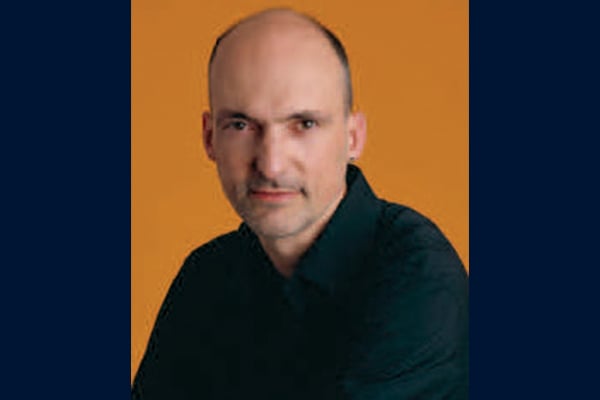Patrick Kanold joined the Johns Hopkins Department of Biomedical Engineering as a professor in July 2020. In this interview, he shares details on his passion for science and neuroengineering, describes his biggest research accomplishments, and provides a look at what he enjoys doing outside of the lab.
What made you pursue a career in engineering?
I have always liked taking things apart to figure out how they work. I also like to build things and tinker with gadgets. Given my interest in electronics and computation, I studied electrical engineering and focused on microsensors and VLSI hardware design. I became intrigued by genetic algorithms and the even more complex capabilities of the brain to process degraded sensory information.
Why did you choose Johns Hopkins BME? What are you looking forward to most?
I came to Hopkins BME as a graduate student after completing my undergraduate and MSE degrees in electrical engineering at TU-Berlin in Germany. The full immersion and intense atmosphere drew me in, and I was hooked by the quantitative approach to biological problems of my thesis mentors Eric Young and Paul Manis. Once at Hopkins, I learned to love the incredible collegial atmosphere.
I came back to biomedical engineering as faculty because BME is the model for 21st century life science, and I wanted to be in the middle of it. We, as a field, but also in my lab, are working on more and more complex projects that require multidisciplinary teams of scientists. To make this work, individuals have to be multidisciplinary as well in order to communicate and understand each other. There are tremendous synergies here, especially with respect to artificial intelligence and neuromorphic engineering. Thus, as a hybrid engineer/neuroscientist, I look forward to growing the field of neuroengineering, learning a lot, and working with the JHU community. I am especially looking forward to collaborating with and learning from clinicians, and applying some of our findings.
Can you give a brief overview of your current research?
The brain develops its incredible complex circuitry from a set of pretty minimal genetic instructions on interacting with the world. This interaction with the world is very fascinating to me. My laboratory is focused on the cortical circuits that underlie sound processing, and how these circuits are built and tuned-up during development.
Currently, we are looking in the adult brain to understand how sound information is encoded in neural ensembles, how this code is adjusted with different environmental conditions (for example, in noisy environments), and how this is done by altering circuits.
We are also trying to figure out when and where in the cortex the influence of the environment starts. To this extent, we are looking carefully at circuits in very young animals. I have been working for a while on this cool group of neurons, called subplate neurons, that predominantly exist in developing cortex, and trying to figure out what they do before they disappear. For our research, we are using many optical techniques as they enable us to track and manipulate the activity of groups of neurons. For me, as a trained electrical engineer, it was fun to learn how to play with light.
What do you consider your biggest research accomplishment so far?
There are two accomplishments. I feel most attached to showing that subplate neurons play a key role in cortical development and plasticity. There are lots of these neurons in humans, and I think this is really important in a clinical sense. We have also shown that the functional organization of the auditory cortex is different than previously assumed. Some of this debate actually goes back to work by Moise Goldstein at BME in the 1970s, and now we have tools to dig deeper.
What impact would you like your work to have?
First, I would like to see some translation of our work into clinical practice. For example, we know so much about the developing brains and signatures of maldevelopment. However, in the clinic, the developing brain is not monitored very well. It would be great if we could develop biomarkers to predict outcomes and have interventions happening earlier.
Second, I would like to grow the field of neuroengineering. We are able to build amazing tools to study and manipulate the brain, but many tool builders and users are still growing up in different departments and communities. I think the unique nature of Hopkins BME can be transformative by bringing together different disciplines.
What are your goals for the future?
We have a lot of cool technology that allows us to look at neural circuits in a pretty static context when we study animals. I would like to make this technology work more in a real-life context. Then we can monitor online how neural circuits change when animals learn as they grow or when they interact. This would also be a great way to tweak neural processing in a targeted way. I would also like to move things out of the lab into the clinic.
Do you have any career advice to offer to current students?
Don’t overthink, and don’t be afraid of the unknown. Go explore and be open to interesting outliers in your data that point you in a new direction. Then embrace the unknown and start asking interesting questions. And don’t be afraid to fail, as failure is part of the process. Also read widely.
What do you enjoy doing outside the lab?
I am a runner, and I also like hiking, camping, and biking. I enjoy very long trail ultramarathons, and I like the simplicity, solitude, and mental challenges of it. Running is also a great way to discover new places when traveling, and it has meditative qualities that help to bring up new ideas.
Is there anything else you’d like to share?
I see the lab as a playground with fun toys, so I enjoy playing in it.

